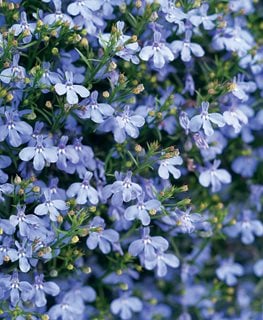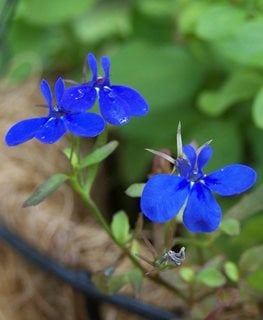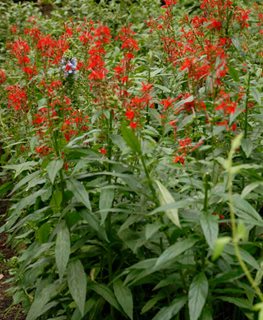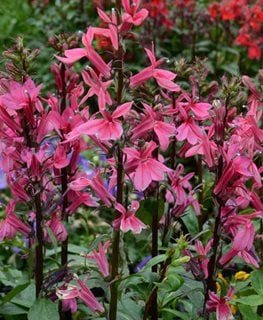Growing Lobelia Flowers in Your Garden
Whether you want to perk up your containers, create a colorful border, or illuminate a woodland garden, there's a lobelia plant to suit your purpose. Updated 01/17/2022
Laguna® Dark Blue Lobelia erinus
Photo by: Proven Winners
My favorite color is blue, so I go absolutely giddy every spring when annual lobelia plants start showing up at my local nursery. Not only do many varieties have true blue flowers, a rarity in the garden world, many also love cool weather and are in full splendor during spring and fall. They are a must-have for my spring containers, and anywhere else in my garden where I want to add a blast of blue.
They're not just a one-color wonder, nor are they always a tender annual. There are more than 400 species that include upright and mounding lobelias, annuals, half-hardy annuals, perennials, and even shrubs and aquatic plants. And although cobalt blue may be their signature hue, you’ll also find lobelia flowers in scarlet red, lilac, rose, and vibrant tropical colors.
On this page: The Basics | Types | Growing Tips | Care and Maintenance | Pictures | Design Ideas
On this page:
BASICS
Hardiness:
Grown as an annual in most zones; perennials vary by species
Height:
Annuals reach a maximum height of about 12 inches. Perennials can grow to be 4 feet high.
Exposure:
Full sun to partial shade.
Bloom time:
Varies by species. Most annuals will bloom from spring through fall, with a lull during midsummer.
Garden uses:
Hummingbird havens, garden borders and groundcovers, rain gardens, woodland gardens, spillers in container combinations, pollinator gardens.
How rare are blue flowers?
Very! They make up less than 10% of the plant kingdom. Blue lobelias are among this elite group, which also includes blue sea holly (Eryngium planum), Siberian larkspur (Delphinium grandiflorum), Lily of the Nile (Agapanthus africanus), Texas bluebonnets (Lupinus texensis), blue daisy (Felicia amelloides), and blue hydrangeas. See more of our favorite blue flowers for your garden.
TYPES
Although there are hundreds of lobelia varieties, these are the types most commonly grown in the home garden:
- Edging lobelias (Lobelia erinus) and their hybrids are tender perennials grown as warm-weather garden annuals. Often grown as container and edging plants, they can have bushy or trailing habits. The tiny five-petaled flowers bloom in shades of blue, purple, rose, and white, with some accented by white eyes.
- Cardinal flower (Lobelia cardinalis), named for its showy spikes of scarlet-red flowers, is the most popular perennial variety. Some varieties also have ornamental reddish-bronze foliage. A North American wildflower native to wet areas, cardinal flower can be found growing in marshes, stream banks, and low woods.
- Great blue lobelia (Lobelia siphilitica), also called blue cardinal flower, is another native perennial wildflower that bears long-lasting bright blue flowers.
- Lobelia ×speciosa are popular garden hybrids (usually of L. cardinalis and L. siphilitica) with flowers in shades of blue, lavender, pink or red and a long summer bloom period.
What about Lobelia inflata, commonly called Indian tobacco plant?
Due to serious toxic effects, L. inflata is not commonly grown as a garden plant. It has, however, been used for medicinal purposes for many years.
GROWING LOBELIA

Container combination featuring Laguna® Sky Blue lobelia.
Photo by: Proven Winners.
When to plant:
In spring, after the danger of frost has passed.
Where to plant:
Most prefer moist, hummus-rich, slightly acidic soil. Some perennial varieties, such as cardinal flower, prefer boggy conditions and can even be grown in standing water.
Light requirements:
In midsummer, most will need some shade to keep them blooming, with the exception of those with improved heat tolerance.
Water requirements:
Water regularly to keep the soil evenly moist, especially during hot, dry weather. Container-grown plants may need daily watering to maintain consistent soil moisture.
Growing from seed:
Although annual types are widely available at garden centers in the spring, you can also start your own plants from seed, sown indoors 8 to 10 weeks before the last spring frost date. Don't transplant seedlings outdoors until a few weeks after the last frost date. Perennial lobelias will often self-sow given the right conditions and usually bloom the first year from seed.
Growing in containers:
Plant in a potting mix rich in organic matter. When using them in mixed container combinations, be sure to team them up with other moisture-loving shade-tolerant annuals and perennials, such as violas, impatiens, and sweet alyssum.
LOBELIA CARE AND MAINTENANCE
Fertilizing:
Perennial varieties can usually get by with a yearly application of fertilizer or compost in the spring. For annuals, fertilize more frequently or apply a continuous-release fertilizer for flowering plants to sustain them throughout the growing season.
Pruning and deadheading:
Most annual lobelias are self-cleaning, so you don’t need to deadhead them. If blooming slows during the heat of summer, the best way to revive them is to cut them back by as much as one-half to two-thirds, followed by regular watering. This radical pruning will regenerate new growth, and by the time the cooler weather of fall arrives, your plants should be in full bloom again. You can also pinch back plants at any time if you prefer bushier growth.
Avoid pruning back or deadheading cardinal flower and other perennials if you want them to reseed naturally.
Propagating:
Perennials tend to be short-lived, but the plants are easy to propagate by dividing them in the spring or fall or by taking stem cuttings after your plants finish flowering. Unless you plan to let your plants self-sow, divide them every two or three years to extend their lifespan.
Winter protection:
If perennials are covered with heavy mulch over the winter, the roots can rot, especially in warmer southern climates. If you typically mulch your perennial beds to prevent frost heaving and root damage, use a light layer of mulch that won’t completely cover the basal leaves.
LOBELIA PICTURES
DESIGN IDEAS
- Cascading varieties make attractive spillers in hanging baskets and window boxes.
- Upright varieties work perfectly as a centerpiece (or ‘thriller’) in containers or along borders. They also add height to cut arrangements.
- Add in rock gardens, butterfly gardens, or in a deer-resistant landscaping design.
RELATED:
20+ Rain Garden Plants
20 Blue Flowers for Your Garden
Flowering Plants for the Fall Garden
Flower Garden Design
Container Gardening Ideas













